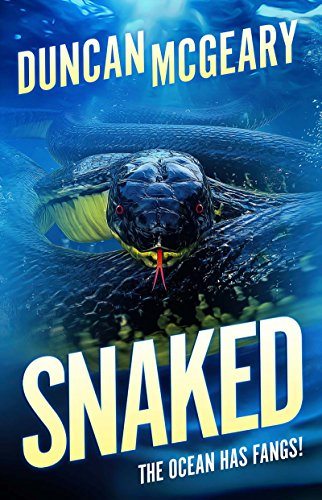Snaked: Deep Sea Rising
Duncan McGeary
Cohesion Press
2017
Reviewed by Michael R. Collings
Some years ago, Dean Koontz spoke to my Creative Writing class at Pepperdine. In a discussion afterward, he talked at some length about giving readers an appropriate payback—just compensation for their investment in money and time in reading his books.
Part of that recompense took the form of internal suspense. He mentioned a scene in one of his earlier novels in which one boy is searching for another amid abandoned cars in a junkyard…and doesn’t find him. The scene could have been accomplished—as I just did—in a single sentence. Instead, it extends over a dozen or so pages, each taut with implicit danger, each building on the suspense inherent in the previous one. By the end of the scene, the reader waits breathlessly for the next twist in the plot, satisfied with every word of the junkyard search.
Knowing that his readers would respond to the potential horror of the situation, Koontz played it out to its fullest limit.
Given that as one criteria for a successful horror/thriller, Duncan McGeary’s Snaked: Deep Sea Rising is a rousing success. From the opening page, scene after scene fully exploits the terror implicit in its thesis: deadly, poisonous sea snakes are rising from the ocean’s depths, attacking and killing any living thing.
Capable of surviving on land or underwater, they act with a coordinated intelligence that terrifies. Their bite is almost instantly fatal; mere touch takes a second or two longer. They ride the waves in their hundreds and thousands, attacking ships at sea, insinuating themselves into the sewer systems beneath Seattle, overrunning high places that otherwise might offer safety.
Worse, they are guided by a more monstrous creature, one with an intrinsic malevolence that threatens humanity.
And even worse still, they are merely the forerunners of a vaster destruction: a tsunami triggered by earthquakes on two faults just off the Washington coast. What survives the snakes is doomed by the water; what survives the water is doomed by the snakes.
Into this concatenation of horrors, McGeary thrusts a score of key characters, each of whom must struggle against the increasing and apparently never-ending intensification of danger:
- Two scientists from the University of Washington set out to examine an unusual specimen and find themselves fighting for their lives.
- A young surfer, son of a billionaire land developer, discovers meaning in death; his father finally realizes what is more important than money or power.
- Two near strangers, largely prisoners within their own minds, find a means by which they can not only rejoin humanity but help save it…if they can survive to do so.
- A nonagenarian shaman finds himself living out the ancient stories of his people and in doing so becomes the stuff of legend.
Snaked attempts much—including detailing the most destructive tsunami in living memory. In general it succeeds, largely because it follows individuals and allows their tragedies to stand for all others like them. It focuses the devastation to their perspectives and makes the unimaginable tangible and visible. And it gives each of them their due as humans, devoting full attention to their often-futile battles for life.
It is a creature-feature on a grand scale, a disaster epic with its own arsenal of special effects. It has its moments of near comedy, as when one character escapes the tsunami riding atop a huge desk that had become the focus of her life. And it has its moments of tragedy, as when, reminiscent of Daniel Keyes’ magnificent Flowers for Algernon, a character realizes that his newly found connections with humanity are dissolving.
For a roller-coaster ride through disaster and devastation, give Snaked a try.









